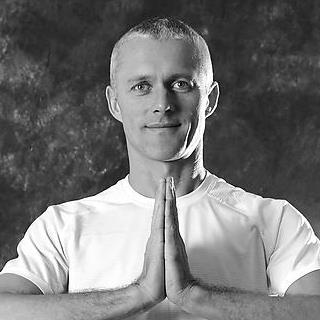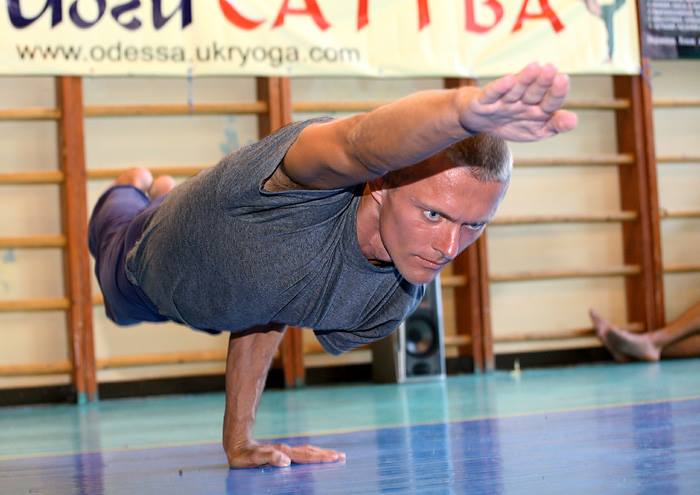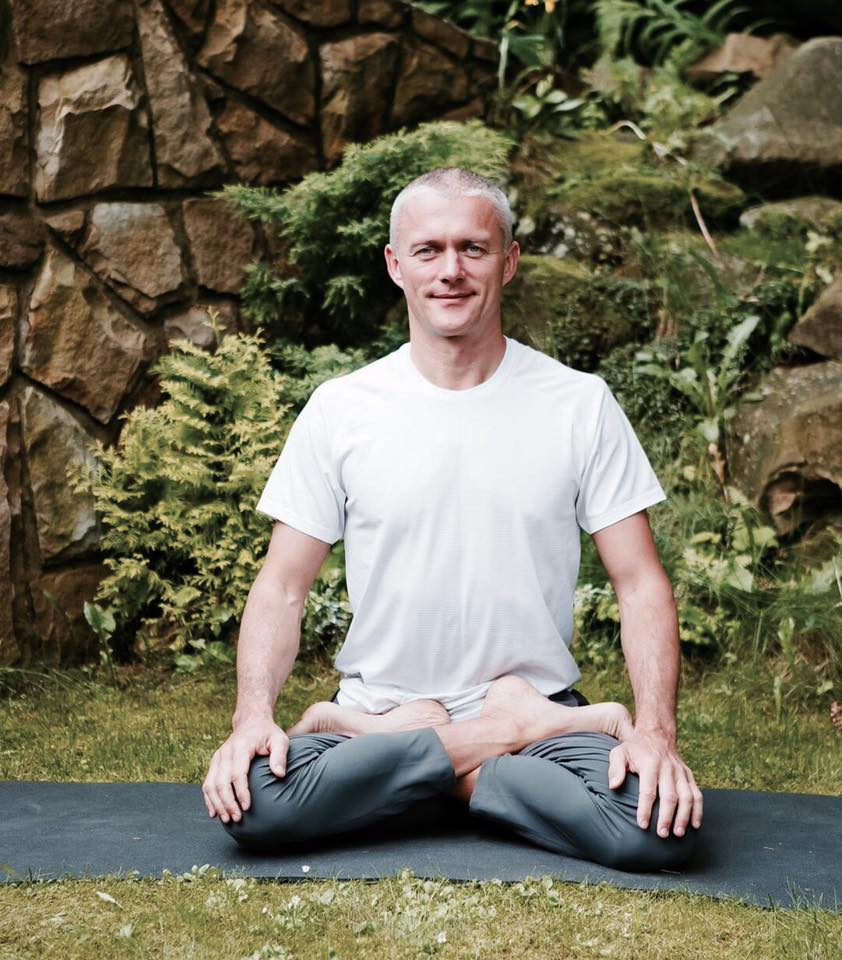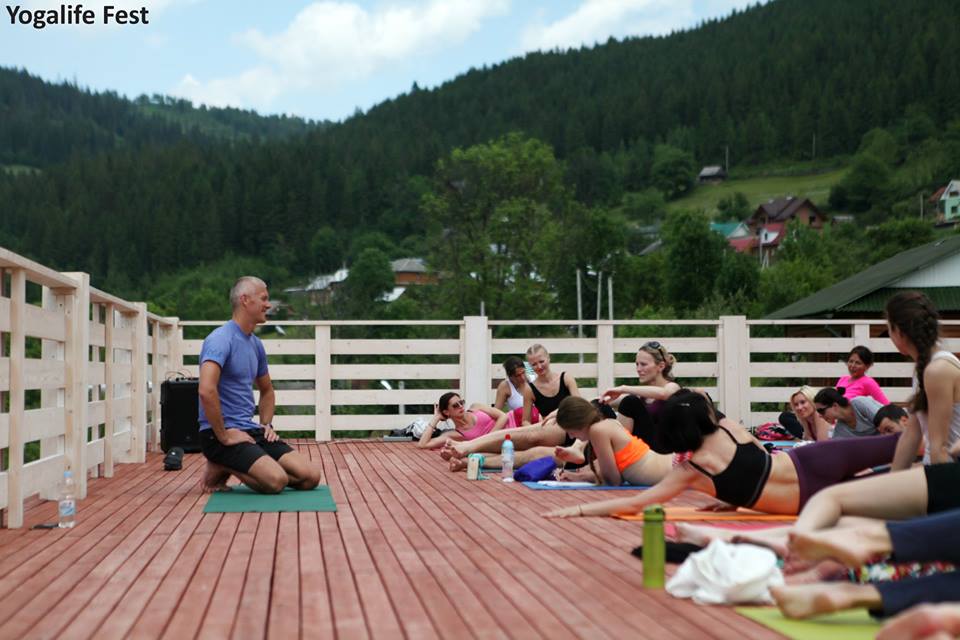Interview with Slava Gutsaluk about healthy approach to yoga

Slava Gutsaluk is one of the most positive-minded and friendly yoga instructors in Kiev, Ukraine. His classes are well-structured, safe, moderately intense, and always inspiring. Slava has told with TopYogis about his approach to hatha yoga, developed as a result of extended practice and application of physiological knowledge to yogic techniques. He told us why his classes are mysticism-free, why headstand is not good for you, what are the principles of healthy nutrition, and many other things.
TopYogis: Slava, what is your goal in yoga?
Slava Gutsaluk: I think that the goal of yoga is freedom. Freedom from restrictions. Health restrictions are one of the problems that motivate people to practice yoga.
TopYogis: So you are interested in mostly therapeutic aspects of yoga?
Slava Gutsaluk: Yes, only therapeutic, no esoteric revelations, only things that one can explain in simple words and everyone can understand them. As one of the teachers said, we live in the world of deceived deceivers. If we want to to be deceived, we listen to things that sound mysterious and ambiguous to us and we admire them.
Also, we look at the reactions of other people and we follow them because we have mirror neurons in our brain that make us copy behaviors of others. If we see many people excited about this kundalini thing, we get excited also and we dedicate our lives to developing it without knowing what exactly this process is. Maybe it’s not such a fantastic thing to dedicate one’s life to.
TopYogis: Yes, I have a heard a couple of horror stories about kundalini awakening.
Slava Gutsaluk: Something not very compatible with life, isn’t it?
TopYogis: Yes. So you try to avoid practices like kundalini?
Slava Gutsaluk: Not only practices, I try to avoid esoteric things altogether. Because I believe that we should understand what we do in our practice. How can we find our way in a dark room? We will stumble a lot. We can find our way only if there is at least some light in it. We should do things that we understand. If you know how to use a knife, you can cook nice food and feed other people. But if you do not know how to use it, you can hurt yourself or others.
TopYogis: You said in the class that yoga has this effect: either it makes you feel better, or if you do something wrong, it makes you feel worse.
Slava Gutsaluk: Yes, we all have experienced this at some point. Because yoga works with our body, and our body is a machine that is subject to constant change, once in a while we get injuries, some micro tears, pulls, because nobody canceled laws of physics. We are just like every other object in this world, we are subject to constant change. And if we push too much, or if we are not attentive enough, we can cause excessive tiredness, micro tears of tissues, injuries. Also, a multitude of other factors influences us: our emotional and mental state, our food, our mood, our sleep, a situation in the family, social changes, and many others. That’s why the practice should be careful, gradual, and we need to pay attention to what we are doing. Because if your attention is somewhere else while you are doing yoga, you may injure yourself.
TopYogis: Have you had injuries related to yoga?
Slava Gutsaluk: I did in the beginning of my practice. I had pains in my lumbar and my upper back. I had microtears in my knee joint, because at that time, I had a wrong approach to yoga, a competitive mentality. Just as we have street traffic rules, we have rules in yoga. These are the rules of comfort, of quiet relaxed breathing, of gradual practice, rules of an extended spine and open joints. We need to abide by these rules in our practice.
TopYogis: The timetable of the studio states that you teach an original program of yoga. What is the difference between your class and generic hatha yoga class?
Slava Gutsaluk: There is a classic style of hatha yoga. You can say it is an orthodox practice of body-related yoga. I use elements from this practice, but I critically inspect each of these elements from the point of view of modern physiology knowledge. And I omit some of the practices that can be traumatic according to the modern understanding of body functions, even though those practices are recommended by classical hatha yoga.
 TopYogis: By the way, what do you think about headstand?
TopYogis: By the way, what do you think about headstand?
Slava Gutsaluk: I think that one should not stand on the head. Our neck is designed to support the weight of three to five kilograms, the weight of the head. If we put the entire weight of our body on the neck, it will not be happy, believe me. The cervical spine is of paramount importance for proper functioning of nervous system. Here we have nerves of the autonomous nervous system going from the brain to our body, here we have an artery that nourishes the brain with oxygen and nutrients.
What happens when we transfer all our body weight on the neck in a headstand? The cervical part of the spine gets deformed, gets compressed. This can cause problems with innervation of some body parts, as in this region, eight cervical nerve roots branch from the spinal cord that control motor and sensory abilities of different parts of the body. Some of the nerves can be jammed if we deform intervertebral disks by overloading the neck. So we may get some abnormal heart rhythm, or pain in our arms, strange sensation in our fingertips, problems with digestion. And we don’t know why all these things are happening to us, while the reason may be that some nervous tissue has been over-stimulated as a result of a headstand.
TopYogis: So you don’t practice headstand?
Slava Gutsaluk: I don’t stand on my head, I do inverted poses like handstand, forearm stand. But I never stand on my head and I never teach my students to stand on their heads.
TopYogis: I have noticed that some teachers in Kyiv can put people on their heads even during their first class. I am surprised by how confident they are in their knowledge.
Slava Gutsaluk: This confidence can be connected with delayed effect of headstand. Few people feel adverse effects right after the headstand, but they may come home and lose consciousness several hours after the practice. A person can start developing negative symptoms of headstands three days after the practice. Few people connect their health problems with their yoga routines. In reality, we need to do inverted postures, that is very good practice, but we need to know how to do inversions.
TopYogis: Do you have any nutritional principles that you follow and teach?
Slava Gutsaluk: I think that poison is not a substance, it’s the amount of each substance. It’s a complicated art to know how to combine products, but it’s very useful skill. Our cells consist of water (75%), amino acids(12-14%), carbs (4-5%), fats (1-2%), and residual micro-elements, minerals. If we know the composition of the cell, we know what to prioritize in our food intake.
 TopYogis: So you do not teach your students to be vegetarians?
TopYogis: So you do not teach your students to be vegetarians?
Slava Gutsaluk: Our body is not a vegetarian, is not a raw-food eater, and not a meat-eater. It makes no difference to our body from where to extract the nutrients. If you understand the composition of nutrients in your food, you will understand the effect that it will make on your body. But you need to weigh well what you are eating. Your moral standards - can you eat it or not? Your level of consciousness - how did you acquire this food? It’s important that the food that you eat does not go against your ethical principles. Also, I think, our body can always find a substitution for some nutrients. Everything can be synthesized and restored. Even essential amino-acids, we can find them in plant-based products as well. Our body has capacities that we have no idea about. Sometimes we cannot imagine how resilient our body is, how it can mobilize itself, change itself, adapt. My grandmother has survived two hungers and second world war, and she is alive and well today. And believe me, during the war they did not eat much, maybe some bread and potatoes every other day. Some people have survived concentration camps and they are still alive. And they ate very little there.
TopYogis: You know, there is a theory that fasting is good for our body. Even one day fasts can trigger cleansing mechanisms in the body, and it will get rid of toxins and mutated cells.
Slava Gutsaluk: It’s quite possible.
TopYogis: But we don’t like that sensation of hunger.
Slava Gutsaluk: Because we live in the time of hyper-abundance. It overloads our body and our mind.
TopYogis: If a person has only fifteen minutes a day for yoga practice, what would you recommend them to do?
Slava Gutsaluk: First, I would recommend doing some breathing exercises. Secondly, joint and ligament warmup. And third - stretch, some inversions.
TopYogis: You have a lot of breathing exercises in your class. Not so many teachers include pranayamas in their sequences, as they think that students find pranayamas boring.
Slava Gutsaluk: You know, one needs to understand what is the most important for life. A human being can live for 30 days without food, for 7 days without water, and for a few minutes without breathing. It’s very important to breathe correctly, fully, deeply, and I stress on it and try to develop good breathing habits in my students. Swatmarama in Hatha Yoga Pradipika says that breathing is a thread on which we bead the asanas. If there is no thread, how will we bead the exercises? Will these exercises be effective then?
TopYogis: I noticed that you give many pelvic opening exercises.
Slava Gutsaluk: Yes, I give many asanas on pelvic and shoulder opening. Because these are the regions in our body where our main arteries are located. I have developed a program with the aim to work through these zones during a two-week cycle.
TopYogis: Would you give some advice to beginning yogis?
Slava Gutsaluk: Just practice and that’s it. Who am I to give advice? The best way is to show with your example. There is a saying:”Don’t discipline your children. Discipline yourself, and your children will be like you”. People that practice with you, that go to your classes, they don’t listen what you say, they look at who you are and what you do. How you look, what mood are you in, which words you use. This is what people react to. A teacher does not need to be a good talker, he needs to be a good example of what he wants to convey.

If you have practiced with Slava Gutsaluk, please share your experience by leaving a review on his personal page. On this page, you can also contact him and check where he is currently teaching.
Find hatha yoga instructors around the world.
Find yoga teachers in Kiev (all styles)
